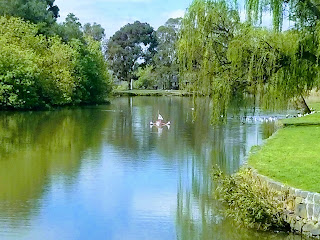 |
| 4 strut tensegrity tetrahedron |
 |
| 6 strut (truncated) tetrahedral tensegrity |
Truncation basically produces the "dual" of a Platonic solid. Cutting the corners of a cube creates the octahedron, cutting the corners of an octahedron brings back the cube. The number of faces becomes the number of vertices, while the number of edges remains the same. However, this beautiful relation does only really exist between hexahedron (cube) and octahedron, and between dodecahedron and icosahedron. Applying the same algorithm to non-Platonic solids creates still very interesting transformations.
The chestahedron, which can into human consciousness just very recently, also has a dual, the decatria. I'm surprised that it took me two years from finding out about the chestahedron to learn about its dual, which still is more than a mystery to me. I know it has 13 faces, 19 corners and 30 edges, mostly likely three different kind of faces. I still struggle to understand the 2d images I saw so far, how many different edge length are involved, so I delayed the ambition to "tensegrify" the decatria.
I got inspired, however, to build a chestahedron similar to the 4 strut tetrahedron, using the tension elements to outline the wireframe version of its geometry. I struggled a lot when tried this for the octahedron, failed completely for the cube so far. The six strut icosahedron doesn't need the additional six strings to unveil it's "true" geometry, my ten strut dodecahedron usually ends up slightly imperfect, with most pentagons not being really symmetric.
 |
| 10 strut dodecahedron |
 |
| 6 strut icosahedron |
I ruminated a lot before getting hands on, using my experiences of building asymmetric structures to have a plan which made sense to me. I got frustrated on earlier attempts to construct things which seemed initially possible, but then turned out quite different. The idea to use seven struts for building a seven-sided object with seven corners kept me going. As the chestahedron has an unfolded tetrahedron at its base, the first tensegrity shape conceived in modern times might provide a great starting point.
 |
| This constellation was build in the 1920s before the term "tensegrity" was coined. |
My first attempt followed my intuition. I chose three different length for the struts: 30cm for the base, 20cm for the vertical riser, and 15 cm for the middle section. The length for the outer tension network were simple, using the edge length relations Frank Chester published for the chestahedron. 9 strings were knotted to 30 cm, 3 more to 16cm, for a 0.53 ratio between top and base edge. In the truncated version, the top seemed to sink a bit in, distorting the beautiful relation of the solid object.
 |
| Healing heart (made of yarrow with suspended copper wire spiral) |
It was relatively straight forward to get everything together. All I needed to do was to connect the bottom of the vertical riser to the top of the base struts, creating an expansion from bottom to top through the inside which should be limited by the tension network on the outside. It got a bit fiddly, all seven sticks come together fairly close in the centre, but there were only two connections to go.... and then everything fell apart in a tangle of sticks and strings.
So decided to use some transparent elastic string to stabilise the base, making a classic nine string, three strut tensul out of it. It still took some dexterity to finish it, yet this the little deviation from making it as minimal as possible provided a satisfying prove of the concept which emerged less than 24 hours in my mind.
 |
| Very first seven strut tensegrity chestahedron as prove of concept |
I probably stopped using non-stretchy string for smaller objects after having some careless punters breaking my sculptures. I think it was Edison who mentioned that "you cannot make things foolproof, because fools are so damn inventive". I liked the idea to show the framework of a chestahedron with the outer tension network of a tensegrity, while hiding the supporting inside tension with transparent string.
When I measured the draft I made, I noticed some variations of lengths, so I chose some very similarly prepared struts and dedicated some time to prepare my strings with as much precision as possible. The second model looked promising already in its early stages.
 |
| Unfolded tetrahedron, four equilateral triangles |
 |
| Seven strut chestahedron |
Here you go. An object with seven vertices, seven faces made with seven sticks and seven supporting transparent strings. Can it get any better? Most certainly. I used three different length for the struts, introduced new length for the invisible support. The perceived centre moved up, although it still seems to divide the structure with the golden ratio.
Now that I know how to build a version of it, I'm curious how to explore this shape even more. It's close to my heart.... as it is the scaffolding needed to create a heart in first place. Stay tuned.
Now that I know how to build a version of it, I'm curious how to explore this shape even more. It's close to my heart.... as it is the scaffolding needed to create a heart in first place. Stay tuned.


















